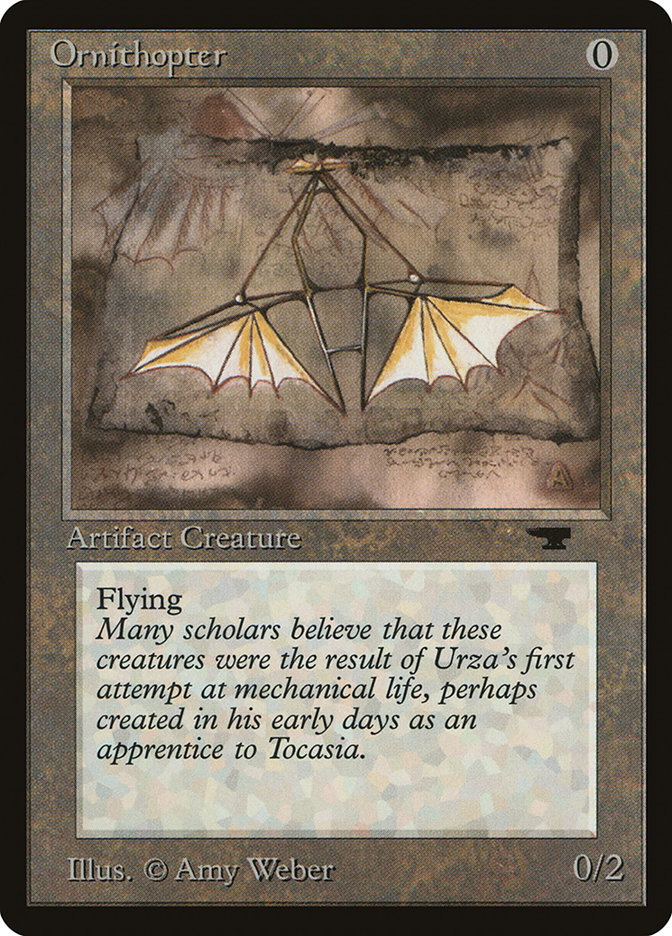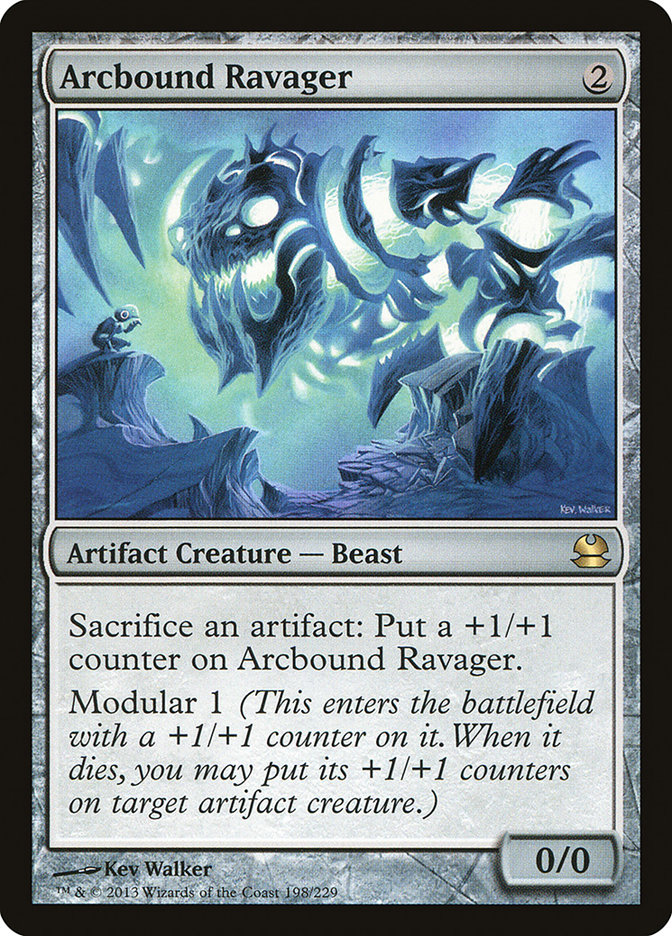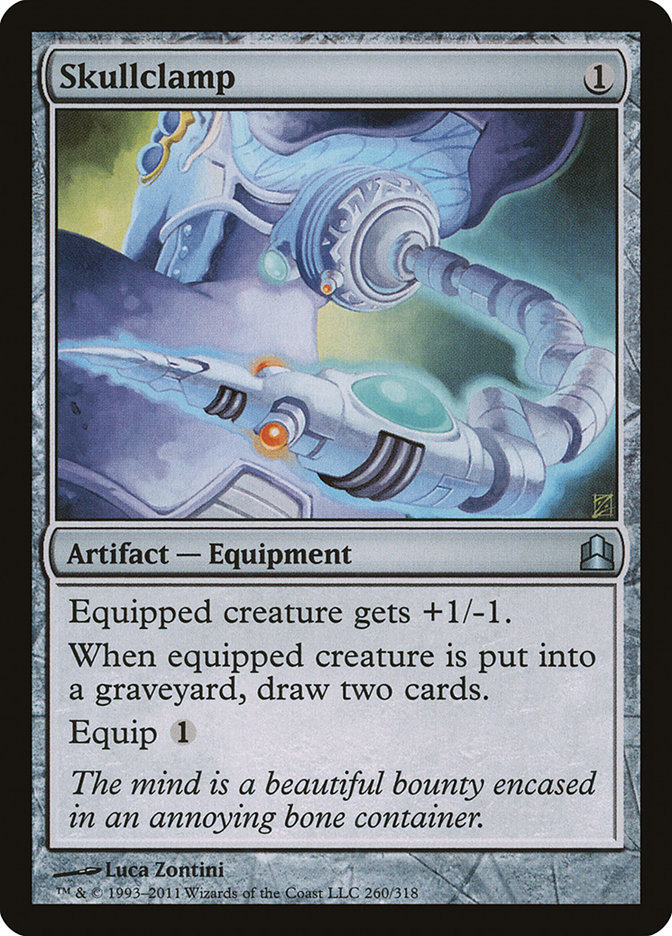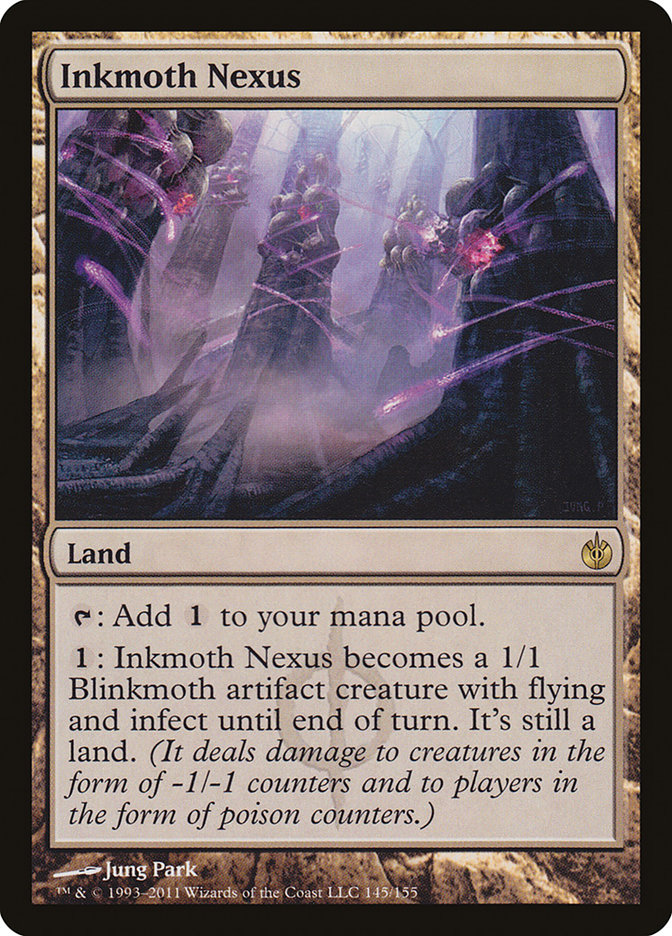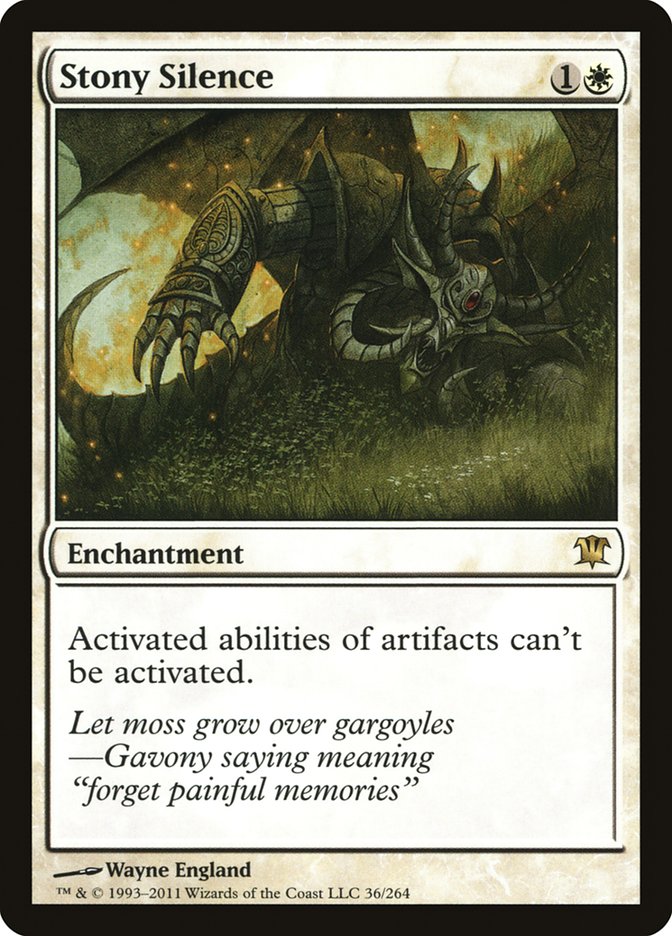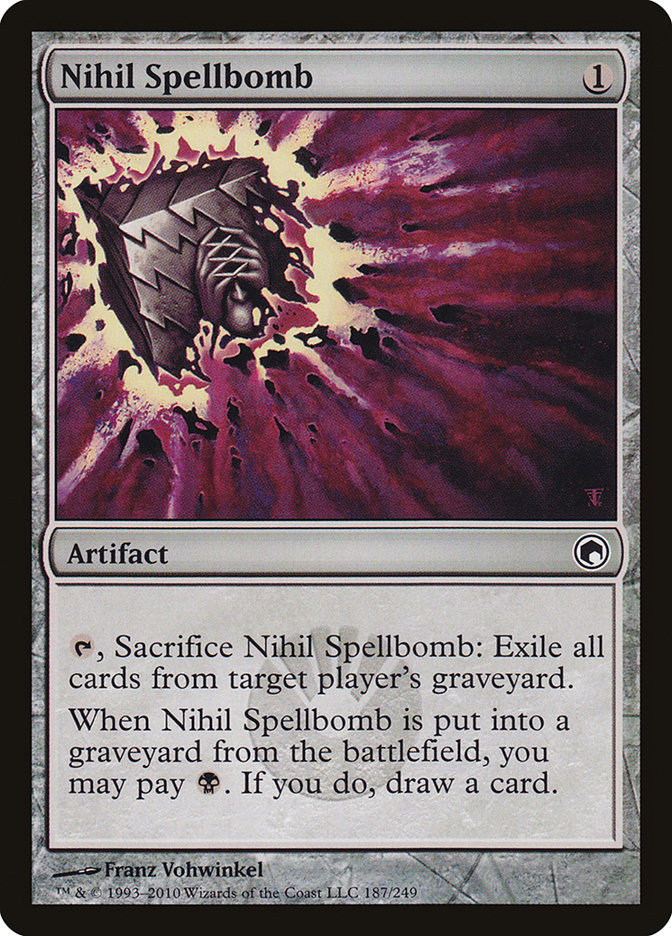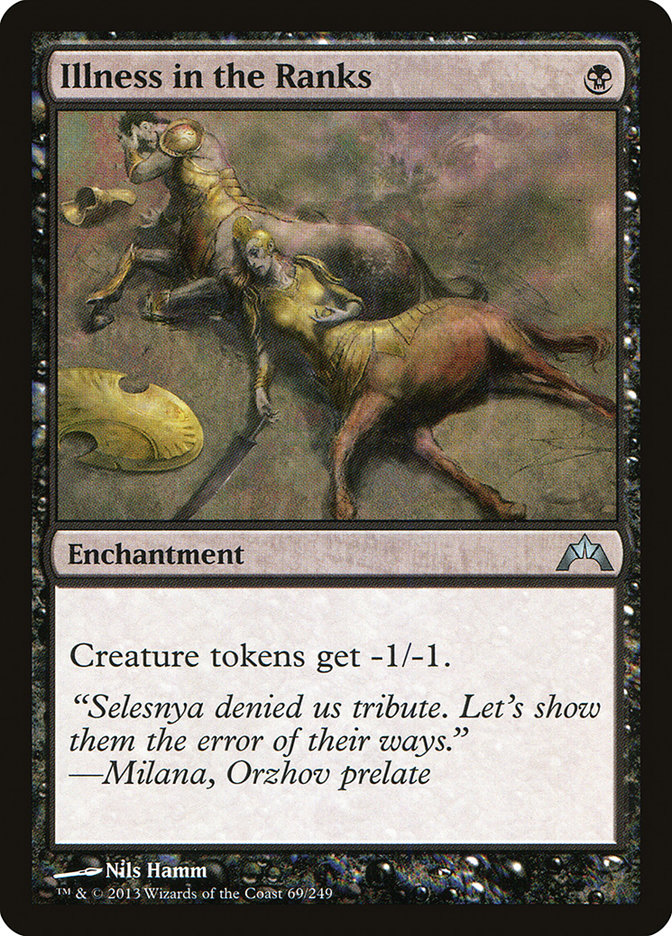Modern is currently my favorite Constructed format to play. I love the balance, the different decks, the interesting game play, and the large card pool.
Last weekend I got a chance to play the format at Grand Prix Kansas City and had a pretty decent outing, going 11-3-1 and finishing in 24th place out of nearly a thousand players.
My weapon of choice was an unlikely one (for me at least): Affinity.
Creatures (24)
- 4 Arcbound Ravager
- 4 Ornithopter
- 3 Steel Overseer
- 2 Memnite
- 3 Etched Champion
- 4 Signal Pest
- 4 Vault Skirge
Lands (16)
Spells (20)
Sideboard

"Not a very powerful Magic card."
Let me begin by saying that I traditionally favor decks that are full of cards that are on their own very powerful. In Modern, I usually play decks like U/W/X, Junk, and Jund in which every single card is good all by itself.
Affinity is the exact opposite of what I am used to playing with in the sense that most of the cards in the deck are not individually powerful but are extremely synergistic with one another.
Ornithopter is a perfect example of this phenomenon.
Most Draft or Sealed decks simply wouldn’t even bother to play an Ornithopter because by itself it accomplishes very little besides chump blocking. However, in a streamlined Affinity deck it actually does a lot of work.
On turn 1, it is often a Llanowar Elves with haste by turning on metalcraft for Mox Opal or immediately tapping in combination with Springleaf Drum. A free hasty Llanowar Elves is powerful.
As the game progresses, Ornithopter (despite having no power of its own) can attack for damage in combination with Steel Overseer, Signal Pest, or Cranial Plating.
In the later turns, if an Arcbound Ravager hasn’t already eaten the Ornithopter, the card is actually a pretty good place to sink modular +1/+1 counters or to wear the hat (Cranial Plating) because it has flying.
A lot of cards in the deck feel very similar to Ornithopter—Springleaf Drum, Mox Opal, Vault Skirge, and Signal Pest—in that when they are isolated from synergistic interactions it is very obvious that they are weak cards. But when they are all teaming up and working together, the output and end result is one to be reckoned with!
The way I came to battle with Affinity is pretty interesting.
I drove down to KC with a car of Michigan guys and ended up staying at Kyle Dembinski’s house (thanks, Kyle!) with Ari Lax, Alex John, and Jon Johnson. I’d brought Patrick Sullivan Tribal Zoo deck and was planning on playing it the following day in the tournament.
The fourteen-hour drive had left me pretty exhausted, and one thing I noticed while playing games with my friends was that the excessive amount of fetching, thinking about what lands to fetch out each turn, paying life, and shuffling was really taking its toll on me (as I was already really tired).
I figured that I was only going to be able to get five hours of sleep tops and that this would likely be the case the following day during the tournament. Alex had mentioned he had an extra Affinity deck in his bag with him, and because I didn’t want to be bothered with shuffling my deck an extra 300 times on Saturday, I switched to Affinity!
"A card for individuals who cannot be bothered to shuffle."
Since the beginning of Modern, Affinity has been a "known commodity" in the sense that it has always been a deck that people know is powerful.
Now that I have played it myself, I know that it is deceptively difficult to play well.
Many people have the opinion that you simply spew all of your cards onto the table and say "is this good enough?"
I strongly disagree with such a statement and in general disagree with this sentiment about any linear deck in Magic. Every deck has its subtle nuances, even if the strategy is linear or non-interactive, and Affinity has a lot of nuances.
The last time I had played an Affinity deck was in Standard, and the deck had four copies of Skullclamp…
"It’s been a while since I last played Affinity."
Needless to say, going into the tournament I was not an expert on playing Affinity by any stretch of the imagination. However, a person learns quite about a deck and how to play it well over the course of a fifteen-round tournament.
Here are the top four nuanced aspects of playing Affinity that I learned over the course of the tournament.
#4: Keepable Hands
One of the biggest lessons I learned about playing Affinity was that the strength of the opening hand is everything.
Since the deck is comprised mostly of synergy "cogs" (Ornithopter, Memnite, Springleaf Drum, Vault Skirge, Signal Pest), the odds of drawing a high-impact threat off the top of one’s deck is relatively low compared to other decks that draw more individually powerful spells off the top of their deck every turn.
To account for this, it is super important to keep hands that have a good mix of spells and mana that start getting to work early.
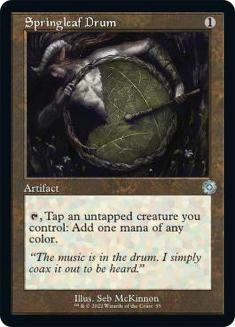
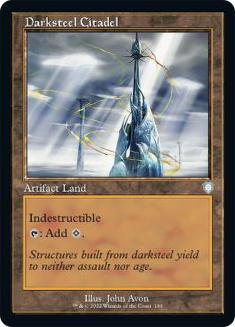
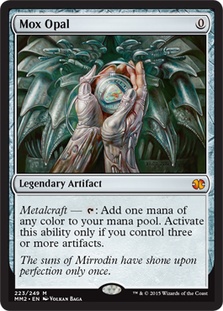
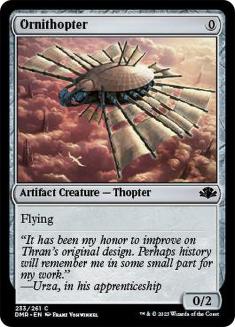
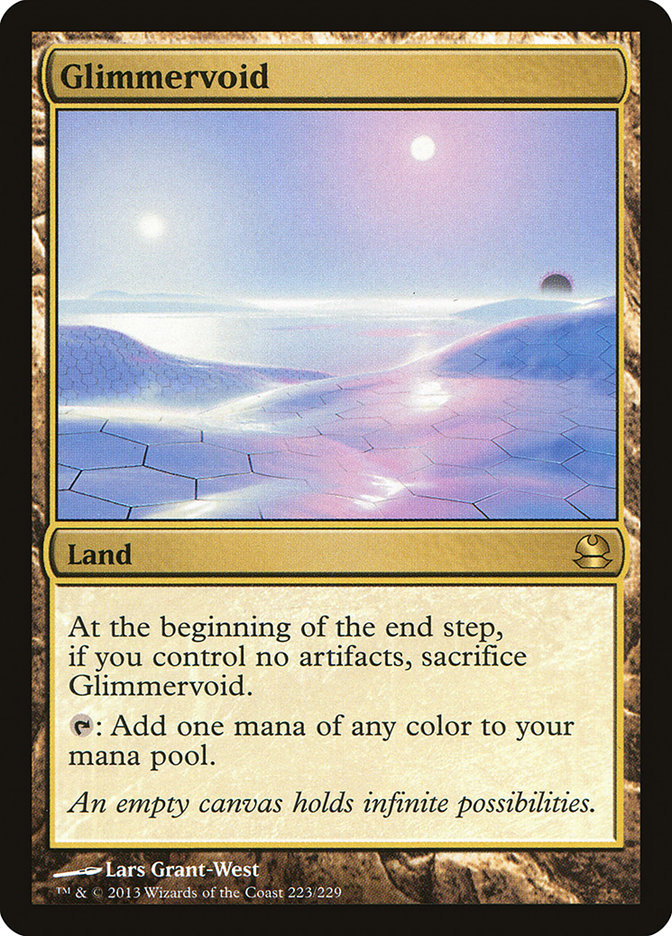
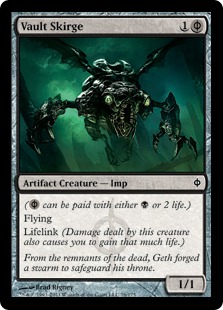
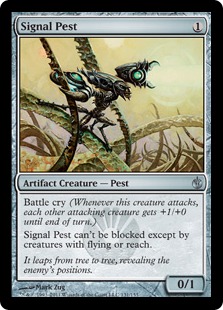
"This hand is too weak."
The first important lesson I learned with Affinity was in round 4 when I kept this hand of seven in game 3 against a Jund (splash white) deck. I had just lost game 2 on the draw to a Stony Silence and tanked for a full minute before deciding to keep this hand.
My rationale for keeping (which I think is reasonable but nonetheless wrong) is that my hand produces three power of attackers on the first turn and can play any spell I draw for the rest of the game.
The problem is that the hand folds up to a single removal spell and basically must draw a quality threat within the next two draw steps in order to be good. Unfortunately, there are far more bad draws than good ones, which makes this hand (unbeknownst to me at the time) a very easy mulligan.
Even more unfortunately for me, my opponent’s keep of seven cards was actually quite weak (i.e., no Stony Silence), so if I’d mulliganed to a reasonable six or even five, I would’ve had a good chance of winning.
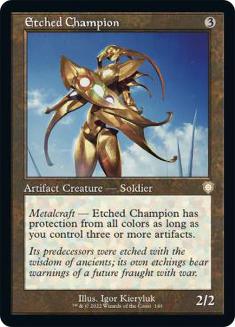

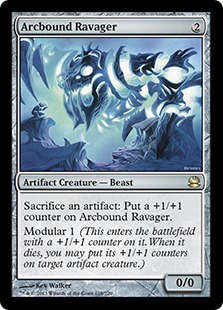

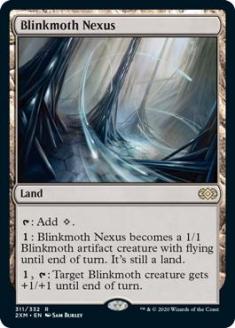
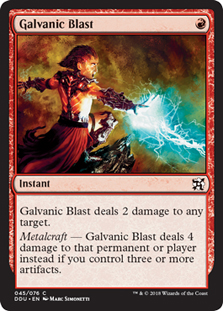

"This hand is too slow."
With Affinity, you have to get on the board early.
Its biggest advantage is that its cog cards let you get ahead and then make plays to stay ahead. If you don’t get ahead early and milk the advantage, it actually turns out that even the most powerful cards in the deck (Arcbound Ravager, Cranial Plating, and Steel Overseer) can get clocked and defeated by Tarmogoyf and Lightning Bolt!
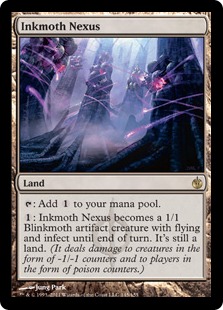


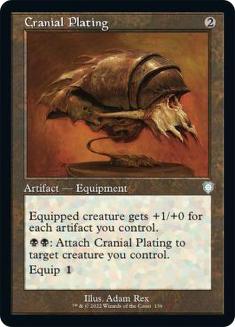



"This hand is juuust right!"
My rule of thumb for playable Affinity hands is as follows:
A seven-card hand must be able to play a spell on turn 1 and cast a two-drop on turn 2 at the bare minimum or else it is almost certainly better to try six cards.
The deck actually mulligans very well, and I was 3-0 in the games where I mulliganed to five. So better to keep looking than to play garbage!
#3: Five Is the Magic Number
I don’t have perfect stats of every game I played, but if I had to put out a number, I would say that I won at least 40% of my games by poisoning my opponent to death.
"Inkmoth assassin."
I was very surprised by how often infect was the path to victory with the Affinity deck, especially considering that there are only four cards with infect in the entire deck.
Nonetheless, poison counters are the most direct, efficient, and easiest way to defeat an opponent. Poison, in combination with Arcbound Ravager’s modular ability and Cranial Plating’s "yee-haw" ability, is very deadly.
One thing I noticed is that you really want to make sure you can get the Nexus to five power the first time you hit them with it so that it is always a lethal threat on the next turn.
It was often a very strong play to sacrifice Ravager to put it up to five to threaten lethal next turn if they were tapped out. Remember that a lot of the removal spells in the format simply will not kill a 5/5 land.
For instance, if Jund has a Lightning Bolt but is tapped out for Huntmaster of the Fells, they simply may not be able to kill it next turn via Bolt, Maelstrom Pulse, Liliana of the Veil, or Abrupt Decay! Taking this gambit rewarded me quite handsomely in the tournament.
#2: No Guts, No Glory Kid
The reason that playing Affinity is hard has nothing to do with the fact that it isn’t powerful. The deck is clearly very powerful and capable of applying a ton of pressure very quickly.
Affinity is a difficult deck to play because it often puts players into positions where they are rewarded for making risky plays.
For instance, sacrificing one’s entire board to kill an opponent is very powerful but also very risky. Sometimes you win, and sometimes they will have a removal spell and end you on the spot for being greedy.
Yet a deck that gives players the option to make insanely powerful gambits has a lot of upside.
Arcbound Ravager is the classic example of this high risk / high reward type of play.
You make an attack with an equipped Ornithopter, Signal Pest, and the Ravager you played last turn. Your opponent plays Abrupt Decay, chump blocks the Ravager with a Deathrite Shaman, and has a red mana untapped.
You can sacrifice your entire board to pump an evasion creature and Galvanic Blast them for lethal, but if they Lightning Bolt or Path to Exile in response to you trying to move modular counters, you are in hot water.
What’s the play?
These are the kinds of plays that make Affinity a difficult deck to play well.
Generally speaking, the odds of going all in are much higher in game 1 than game 2, since everyone is going to have all their cheap removal post-board, which would factor into my decision making.
I don’t really like moving in unless I am put into a situation where it seems like my best chance of winning the game. For instance, in the situation described above they are chump blocking my Ravager, so I am likely winning the game even without making a risky play.
However, maybe my Ornithopter with Cranial Plating got through last turn, so we believe he drew the Decay that turn (as he would have killed Cranial Plating last turn given the opportunity) and we observe that there were some really good targets for a Lightning Bolt last turn in response to the Ravager.
One needs to start thinking about things like what points in the game would he have used a Lightning Bolt if he had one and which turns could he have drawn one and not had a good opportunity to use it.
Every piece of information from every turn of the game can be used to help influence whether to move in or not, and the better a player’s ability to deduce what is going on, the more realistic the odds one can put on their gambit.
It is possible that against a really strong player they are trying to set you up for the o-key-doke if you get greedy, which is worth considering too.
These are the kinds of situations I found myself in over and over again with Affinity, and I was able to give myself realistic odds about what might be about to happen next if I wait or go.
#1: Waste Not, Want Not
As a continuation of the last point, the other half of the coin is a cautionary tale.
One thing I noticed when watching other players battling with Affinity was that a lot of the time people are not realistic about the risks they are taking.
The first opportunity to win the game with some swingy, risky play is very likely to be booby-trapped.
Another thing that I saw a lot involved an Affinity player with two Nexuses, two other lands, and an Arcbound Ravager in play. The Affinity player would animate both Nexuses and attack for six. The other player would do whatever and then untap and kill the Arcbound Ravager, leaving the Affinity mage with nowhere to move his +4/+4 counters.
Greeeedy.
It isn’t worth risking the raw material of four counters over one point of damage.
I am sure the guy had it in his mind that "if he kills my Arcbound Ravager, I will just move it to one of my Nexuses and get the damage." Yet he didn’t have the foresight to think about what would happen if the opponent killed the Ravager on his next turn!
Leaving mana hanging around was a critical tactic for my Affinity deck (especially in combination with Nexus) because it provided me with additional creatures and artifacts for modular counters and also for maintaining metalcraft on my Etched Champion against decks that desperately needed to get it off the board.
Improvements, Insights, and Innovations for Affinity
Observation #1
The first observation I have about Affinity is that in the abstract the deck gets better with the addition of the M14 legend rule.
"The second one is now Lotus Petal."
Everyone already knows that Mox Opal gets better since the second one in your hand is no longer a stone brick but basically turns into a Lotus Petal (as you can play the second and sacrifice the one that was already in play, netting you a man).
However, I will say that I was keeping track of exactly what this means for the Affinity deck as I played my matches in Kansas City.
There were five games where under the new legend rule I would have been able to equip my Cranial Plating a turn faster and attack for between four and six damage. That is five games where it would have gotten me at least five free mana.
There were three games where I could have played a two-drop on the first turn—two of those games it was a Steel Overseer.
That is a grand total of eight games off the top of my head where the second Opal would have created a huge play for me, which is nothing to scoff at.
Observation #2
Affinity reminds me a lot of Dredge in other formats in the sense that you are pretty much heavily favored in game 1 against most decks and then opponents bank on swingy hate to shore up the matchup after sideboard.
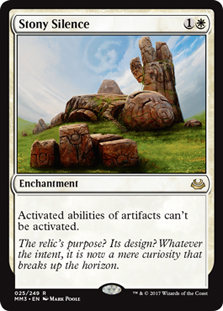
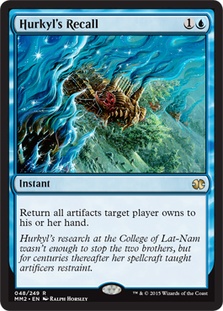
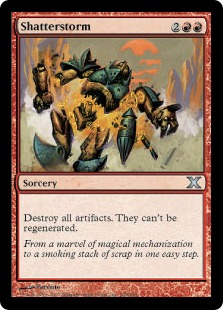
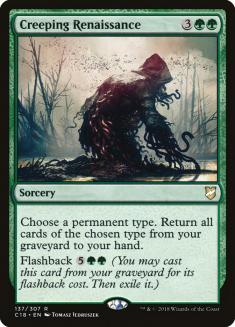


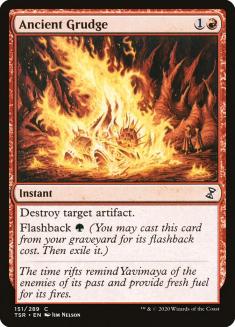
"These are cards Affinity has a difficult time with."
I had an exceptionally high game 1 win percentage at the Grand Prix. In the eleven rounds I played, I went 9-2 in game 1s.
I got beaten by an Infect player on the draw in a game 1 (which is reasonable), and I lost to Brandon Nelson’s Wrath of God + Gideon Jura.
In general, I felt like I was favored to win game 1 against most decks and then that those decks basically needed to draw their sideboard cards in order to beat me post-sideboard.
I beat Ancient Grudge a bunch of times (Etched Champion doesn’t care about that card), but Stony Silence is a totally different story.
"Mirrodin’s public enemy #1."
Not only did I never beat this card when it was played against me, but I was never even close to being in the game when it was played against me.
I have played against Affinity a number of times with various other Modern decks and can confirm from the other side that I have also never lost when I cast the spell against an Affinity deck.
Now, that doesn’t mean it isn’t possible for Affinity to win if the opponent has Stony Silence (there are certainly some draws that are good against it), but in general the card is an absolute nightmare.
I had zero ways to kill it in my 75, which I think is correct since how am I supposed reliably make colored mana with Stony Silence in play (three Glimmervoid)?
My strategy for Stony Silence was basically "I hope they don’t have it!"
I think I can do better than that in the future…
One other thing that I noticed was that I really did not care about my opponent’s creatures at all. All of my creatures are evasive, and most decks are not fast enough to race me, so basically a Tarmogoyf is a brick unless they also have three removal spells to shore up the race.
The only creature I realistically care about is Spirit tokens from Lingering Souls, and I would gladly trade a Spell Pierce for the first half of that card!
Also, all of the cards on my "Mirrodin’s public enemy #1 list" are noncreature spells.
Once I got to actually play the deck and see how things work, the answer became pretty obvious to me:
"No spells for you."
Spell Pierce answers basically every single card that I could ever care about having played against me in Modern, and I believe it is good enough to play in the maindeck.
Also, most of the time countering one of there spells is going to be better than one of your own spells. Countering a Bolt (or, God forbid, Electrolyze) on a creature wearing Plating is likely to win the game on the spot. Countering a Stony Silence, Cryptic Command, or Shatterstorm also probably ends the game.
Here is the list that I would play tomorrow if I went to a tournament:
Creatures (24)
- 4 Arcbound Ravager
- 4 Ornithopter
- 3 Steel Overseer
- 2 Memnite
- 3 Etched Champion
- 4 Signal Pest
- 4 Vault Skirge
Lands (16)
Spells (20)

Against a lot of decks my Thoughtseizes were awesome, and in most of my matchups I wanted to board in Spell Pierce.
I really like how against combo decks Affinity can just have Spell Pierces and Thoughtseizes and essentially be super hateful.
It didn’t punish me at the tournament, but my list had no way to interact with the graveyard.
"Take that, Living End."
Living End, Dredge, and Goryo’s Vengeance are all decks, and I’m sure at some point these cards will easily earn their keep.
"No Infinity Faeries for you!!!"
This combo breaks up every iteration of the Infinity Faeries combo from U/R Splinter Twin. It makes all of their Deceiver Exarch tokens 0/3 and outright kills Pestermite tokens.
Also, there are just straight Token decks out there…
Take that, Lingering Souls!
Here is what I played against at the Grand Prix and how I fared.
R1: Bye
R2: Bye
R3: Bye
R4: Jund with White, Lost 1-2 (Stony Silence)
R5: Jund, with White, Won 2-1
R6: G/U Infect, Lost 1-2 (Hurkyl’s Recall)
R7: G/R Tron, Won 2-0
R8: Affinity, Won 2-1
R9: Jund, Won 2-0
R10: Jund, Won 2-1
R11: Jund, Won 2-0
R12: U/W/R Control, Won 2-1
R13: Scapeshift, Won 2-0
R14: U/W Control, Lost 0-2 (Wrath of God, Stony Silence)
R15: Affinity, Intentional Draw (into Top 32)
I noticed that my play in general got better as the tournament went on but also that I made subtle mistakes throughout the tournament. It would be generous to say my play was at 90% proficiency with the deck, which is something I find very exciting about the deck as a choice.
If I continue to practice and learn the nuances of the deck, I believe my results could become even better, which is a strong selling point for any deck.
It rewards you for playing well but is powerful enough to win even if you don’t!
It seems like the perfect deck for anyone just getting into the format since it is so good that a player learning the deck can still win with it. Also, if one sticks with it and masters it, the deck has a lot of upside.
I sat down for round 9 (which was a win and in match) and my opponent said, "Oh man, this is going to be rough! You probably have some super spicy brew." I won the die roll and spewed out a bunch of Ornithopters on the first turn and a Cranial Plating!
"Nope, just jammin’ Ari’s Antiquities Ornithopters today!"
Affinity is an amazing deck, and I would strongly advise players to take it for a test drive.
But beware: once you cast Ornithopter, you can never go back again!!!
I have the melody of the Katy Perry song "I Kissed A Girl" in my head with the lyric changed to:
"I cast a Memnite and liked it!"

